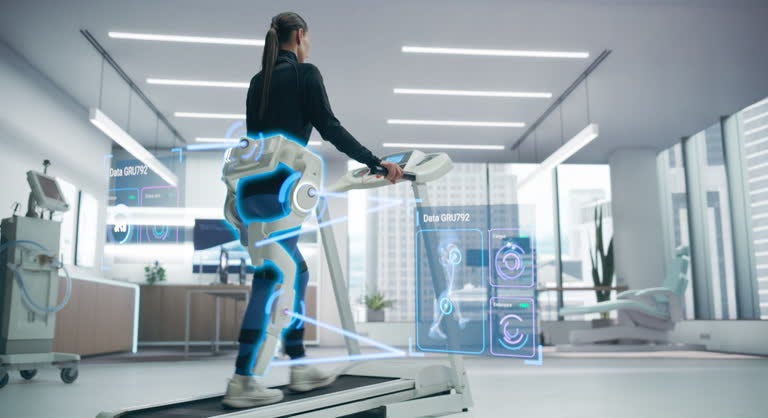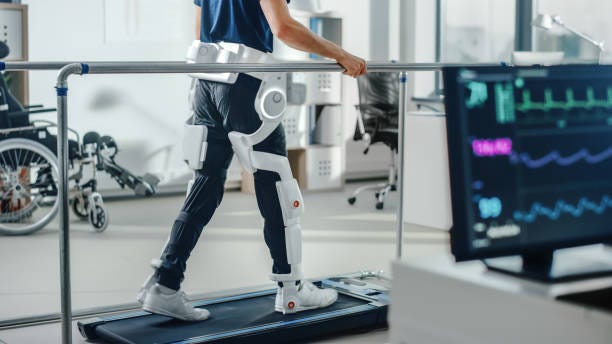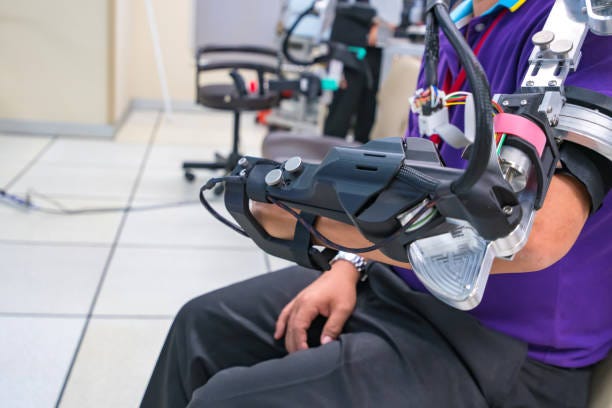Towards a Unified, Accessible Care Continuum
The convergence of advanced robotics, virtual reality, haptics and artificial intelligence (AI) is rapidly transforming healthcare delivery—extending surgical precision into rehabilitation and beyond. This article examines the cascading impacts of these innovations across clinical pathways, operational workflows and commercial models, and proposes mitigation strategies to ensure safe, effective and equitable adoption.
From Isolated Innovations to Integrated Ecosystems
Over the last decade, once-disparate technologies—robotic surgery platforms, rehabilitation exoskeletons, immersive virtual-reality (VR) therapies, haptic interfaces and AI-driven control systems—have begun to merge into cohesive care continuums. No longer confined to single-use cases, these modalities now amplify one another: surgical robots deliver optimal post-operative conditions for exoskeleton-based prehabilitation; VR and haptics sustain high-dose therapy outside the clinic; and AI agents orchestrate data flows, drive adaptive control and support clinician decision-making.
Such synergy promises superior patient outcomes, streamlined workflows and novel commercial opportunities. Yet it also raises complex challenges around data governance, ethics, workforce training, reimbursement and cybersecurity. This analysis unpacks the ripple effects of key technological advances, highlighting six strategic imperatives to guide responsible, scalable integration.
Robotic Surgery: Laying the Foundation for Downstream Rehabilitation
Precision Minimises Complications
Modern robotic surgical systems integrate sub-millimetre motion scaling, 3D endoscopic imaging and force-feedback to refine minimally invasive procedures. A meta-analysis of over 5,000 prostatectomy cases showed robotic platforms reduced intraoperative blood loss by 40% and length of stay by one day compared with open surgery. These improvements not only enhance immediate safety but also create the ideal physiological milieu for intensive rehabilitative interventions.
Cascading Clinical Benefits
Accelerated Rehab Onset: Reduced tissue trauma allows initiation of exoskeleton-assisted gait training within 24–48 hours post-op.
Improved Functional Trajectories: Early mobilisation under robotic guidance reduces muscle atrophy, fostering smoother transitions into virtual-reality-based therapies.
Data-Rich Recovery Curves: Surgical robots capture kinematic and physiological data that inform personalised rehab algorithms, closing the loop between surgery and therapy.
Ensuring Equitable Access
High capital costs and concentration of robotic systems in tertiary centres risk widening disparities. To counteract this, health systems should pilot mobile robotic surgery units and share best practices through federated consortia, enabling smaller hospitals to access remote surgical expertise under supervised tele-mentoring.
Rehabilitation Robotics: Mechanised Dosing of Therapy
Exoskeletons and End-Effector Devices
Exoskeletons now deliver high-dose, repeatable limb movements with adjustable assistance. Modular upper-limb exoskeleton demonstrated a 25% improvement in Fugl-Meyer Assessment scores among chronic stroke survivors after just four weeks of daily sessions. End-effector platforms similarly enable targeted hand and wrist training, filling critical gaps in fine-motor recovery.
Immersive VR and Haptic Coupling
Low-cost VR-haptic glove system merges real-time kinematic tracking with adaptive resistance, gamifying hand-function exercises to sustain engagement. Patients using the platform achieved 30% greater repetition counts than those in conventional therapy, translating into 20% faster gains in grip strength.
Cascading Operational Impacts
Therapist Productivity: Automated progression algorithms free clinicians to focus on complex assessments rather than manual device adjustments.
Clinic Throughput: Standardised, data-driven protocols reduce inter-session variability, enabling predictable scheduling and higher patient volumes.
Home-Based Continuity: Portable exoskeleton and VR kits extend high-quality therapy into patients’ homes, reducing readmission rates by up to 15%.
Standardisation and Certification
Interoperability remains a barrier. Stakeholders must adopt open standards (FHIR, IEEE 11073) for device communication and advocate for a unified robotic rehab certification framework, ensuring safety, efficacy and data portability across manufacturers.
AI-Driven Control: The Nervous System of Robotic Care
Reinforcement Learning for Adaptive Assistance
Deep Q-Network (DQN) frameworks—originally developed for hybrid-vehicle energy management—are now applied to exoskeleton control, dynamically optimising assistance profiles based on patient fatigue and performance metrics. Such closed-loop control ensures each movement remains within safe thresholds while maximising therapeutic challenge.
Agentic AI in Care Coordination
Agentic AI systems autonomously sequence multi-step workflows: extracting wearable sensor data, updating electronic health records, adjusting device settings and flagging anomalies to clinicians. University of Denver’s prototype healthcare assistant reduced administrative load by 35%, enabling therapists to devote 20% more time to hands-on care.
Cascading Commercial Effects
Outcome-Based Reimbursement: Real-time performance metrics justify pay-for-performance models, shifting from session-count billing to value assessment.
Service Bundles: Providers offer integrated “surgery + robotic rehab + AI-guided follow-up” packages, unlocking new revenue streams.
Device-as-a-Service: Subscription models for exoskeletons and software licences lower adoption barriers for smaller clinics.
Ethical and Security Guardrails
As AI agents access sensitive health data, robust zero-trust architectures, continuous red-teaming and privacy-by-design principles must be mandatory. Ethical oversight boards should review algorithmic fairness, particularly in applications involving BCIs and cognitive robotics.
The integration of robotic surgery, exoskeletons, VR, haptics and AI is reshaping healthcare—speeding recovery, optimising resources and spawning novel service models. To ensure these advances benefit all patients, we must:
Govern Data & Ensure Interoperability: Embrace open standards (FHIR, IEEE 11073) and federated learning to share insights securely.
Maintain Ethical Oversight: Convene multi-stakeholder ethics boards and audit AI systems—especially BCIs and cognitive robots—for fairness.
Upskill the Workforce: Embed robotics and AI in health-science curricula and certify “robotics coordinators” to bridge clinical and technical expertise.
Innovate Reimbursement: Shift to outcome-based payment models driven by real-time device metrics.
Expand Equitable Access: Deploy mobile robotics units, share best practices via consortia and subsidise home-use kits.
Fortify Security & Privacy: Require zero-trust architectures, regular red-teaming and privacy-by-design in all systems.
By championing these priorities, clinicians, payers, providers and regulators can deliver cutting-edge, ethically grounded care that is effective, scalable and truly inclusive.
Connect with me on LinkedIn for the full series: https://www.linkedin.com/in/zenkoh/ and subscribe to my newsletter:
Legal Disclaimer
This article is intended for informational purposes only and does not constitute professional advice. The content is based on publicly available information and should not be used as a basis for investment, business, or strategic decisions. Readers are encouraged to conduct their own research and consult with professionals before making decisions. The author and publisher disclaim any liability for actions taken based on the content of this article.









